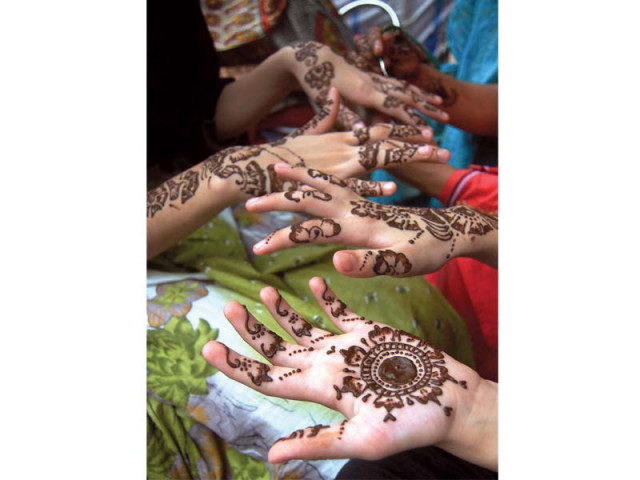Handful of henna: The evolution of mehndi design
Culturally significant temporary tattoos go from family activity to a lucrative small business.

Shahid, 23, who has been doing mehndi designs for the past five years in F-10 Markaz, says he was always artistically inclined. Though he had to overcome a few hurdles convincing his family to let him make a living off his talents, they are proud of him today.
“In our society, parents are never pleased to hear that their children want to become artists. For me, convincing my parents that mehndi design is even an art was the biggest obstacle,” he said.
However, Shahid makes good money, charging Rs500 per hand during wedding season and on Eid for painting the hands of eager women and girls. When he’s not making tactile art, he works with his father as a travel agent.
“I consider myself somewhat of a mehndi aficionado; I get mehndi applied on my hands for every wedding and Eid, even dabbling in it myself sometimes. But I have never seen such intricate and creative designs,” commented Hareem, whose hand Shahid was decorating.
On the cutting edge of new and innovative is Wahida Begum in Supermarket, who believes that chemical mehndi in syringes is not true to tradition. “Mehndi is a sign of celebration and joy, its fragrant scent and colour is what makes it special. The instant gratification of the chemical mehndi strips away the authenticity of the tradition,” said Wahida.
She has been in this profession for the past 21 years and says she first started in Rawalpindi. She reminisces about the days when cone mehndi was ubiquitous and states that those were the days when people were less occupied by outcomes and more by the process. “Nowadays everyone is too worried about how they look and not long term effects, this mehndi has individual colour and fades uniquely but the new mehndi can also burn and flake the skin,” added Wahida.
While Wahida may be right about chemical mehndi flaking and burning skin and the inescapable nostalgic scent of cone mehndi, it is apparent why the worth of cone mehndi has fallen. Compared to Shahid’s intricate designs, Wahida’s are much thicker. However, Wahida says that she doesn’t see herself switching anytime soon.
If one wants to avoid crowds, the comfort of a salon is always an option. Jugnu Waseem Salon in Rawalpindi and Islamabad have pioneered mehndi designs by using a hybrid mehndi. They use the syringe but fill it with mehndi that has been mixed with tea juice.
Nadia Qamar, general manager at JW Rawalpindi says that tempering mehndi with tea juice gives clients the desired outcome of bright colour and little waiting time but none of the burning or flaking associated with chemical mehndi.
There’s a plethora of choices when it comes to mehndi design: chic indoor comfort or the hustle bustle of the market with bangles clanking, the rich aroma of the cone and or the intricacy possible only with a syringe.
Published in The Express Tribune, August 20th, 2012.



















COMMENTS
Comments are moderated and generally will be posted if they are on-topic and not abusive.
For more information, please see our Comments FAQ